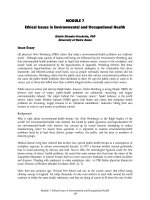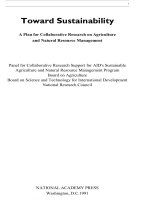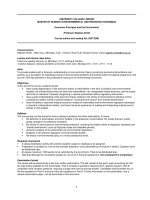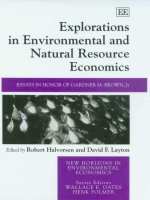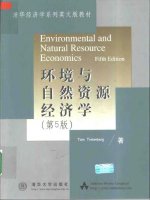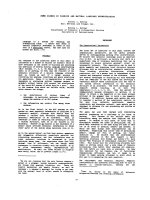three essays in environmental and natural resource economics
Bạn đang xem bản rút gọn của tài liệu. Xem và tải ngay bản đầy đủ của tài liệu tại đây (1.32 MB, 127 trang )
Copyright
By
Garth Aaron Heutel
2007
The Dissertation Committee for Garth Aaron Heutel certifies that this is the
approved version of the following dissertation:
Three Essays in Environmental and Natural Resource Economics
Committee:
Don Fullerton, Co-Supervisor
Dean Corbae, Co-Supervisor
Daniel Hamermesh
Roberton Williams
Shama Gamkhar
Three Essays in Environmental and Natural Resource Economics
by
Garth Aaron Heutel, B.S.; M.S.
Dissertation
Presented to the Faculty of the Graduate School of
The University of Texas at Austin
in Partial Fulfillment
of the Requirements
for the Degree of
Doctor of Philosophy
The University of Texas at Austin
May 2007
UMI Number: 3272342
3272342
2007
UMI Microform
Copyright
All rights reserved. This microform edition is protected against
unauthorized copying under Title 17, United States Code.
ProQuest Information and Learning Company
300 North Zeeb Road
P.O. Box 1346
Ann Arbor, MI 48106-1346
by ProQuest Information and Learning Company.
This Dissertation is dedicated to Amy Benold Heutel
v
I would like to acknowledge helpful comments from Spencer Banzhaf, R.J. Briggs, Russ Cooper, Jason
DeBacker, Larry Goulder, Matt Kotchen, Carol McAusland, Hilary Sigman, Kerry Smith, and various seminar
participants. I am thankful for financial support from the National Science Foundation Graduate Research
Fellowship program, and for data from the National Center for Charitable Statistics. I thank the members of
my dissertation committee, Shama Gamkhar, Dan Hamermesh, and Rob Williams, for their comments and
support. I especially thank my supervisors Don Fullerton and Dean Corbae for all of the academic guidance
I have received while in graduate school. The second chapter of this dissertation is co-written with Don
Fullerton.
vi
Three Essays in Environmental and Natural Resource Economics
Publication No._____________
Garth Aaron Heutel, Ph.D.
The University of Texas at Austin, 2007
Supervisors: Don Fullerton, Dean Corbae
Environmental regulations that grandfather existing plants by not holding them to
the same standards as new plants may have the unintended consequence of retarding new
investment. In my first essay, I develop a dynamic model of a plant's optimal scrapping
decision, which depends on environmental policy. Using data from electric power plants,
I estimate the parameters of the model and assess the impact of the Clean Air Act on
emissions and plant productivity. Over the 1990s, grandfathering provisions increased
emissions by about 78% and decreased productivity by about 3%. Furthermore, I show
that under certain reasonable parameters, given grandfathering, total discounted
environmental damages can be reduced by weakening environmental regulations.
Regulations that restrict pollution by firms also affect decisions about use of labor
and capital. They thus affect relative factor prices and output prices. My second essay
studies the general equilibrium impacts of environmental mandates on the wage, the
return to capital, and relative output prices. It looks at four types of mandates and for
each determines conditions that place more of the burden on labor or on capital. Stricter
regulation does not always place less burden on the factor that is a better substitute for
vii
pollution. Also, a relative restriction on the amount of pollution per unit output creates an
"output-subsidy effect" that affects factor prices in a different way than the traditional
output and substitution effects.
Public goods are provided by both governments and individuals. In response to
an increase in government spending on a public good, individuals may reduce their
contributions. This "crowding-out" effect can occur in the opposite direction. If a
government sees that private donations to a charity have risen, then it may reduce its
public funds to that charity. While the literature focuses on how government spending
crowds out individual giving, the purpose of my third essay is to examine crowding out in
the opposite direction? I test for crowding out using data on private and public
contributions to environmental charities. I find evidence that government grants crowd
out private donations, but evidence is mixed on crowding out in the opposite direction.
viii
Table of Contents
Chapter 1: "Plant Vintages, Grandfathering, and Environmental Policy" 1
1.1: Model 3
1.2: Data 6
1.3: Estimation 11
1.4: Counterfactual Simulations 18
1.5: Conclusion 31
Chapter 2: "The General Equilibrium Incidence of Environmental Mandates" 34
2.1: Review of Environmental Mandates and Modeling 36
2.2: Tradable Pollution Permits 40
2.2.1: Equal Factor Intensities 43
2.2.2: No Substitution in Dirty Sector 45
2.3: Command and Control Restrictions on Firm-Specific Pollution Quantities 46
2.4: "Performance Standard": Emissions per Unit Output 47
2.4.1: Equal Factor Intensities 51
2.4.2: No Substitution Effect in Dirty Sector 52
2.5: "Technology Mandate": Emissions per Unit Input 53
2.5.1: Equal Factor Intensities 57
2.5.2: No Substitution Effect in Dirty Sector 59
2.6: Conclusion 60
Chapter 3: "Crowding Out of Private Donations and Government Grants: Evidence
from Environmental Charities" 62
3.1: Model 65
ix
3.1.1: Exogenous Government Action 66
3.1.2: Exogenous Individual Action 67
3.1.3: Simultaneous Move (Nash) Equilibrium 69
3.1.4: Government First Mover (Stackelberg) Equilibrium 70
3.1.5: Individual First Mover (Stackelberg) Equilibrium 71
3.1.6: First Best Solution 72
3.2: Numerical Simulations 73
3.3: Data 77
3.4: Econometrics 84
3.5: Conclusion 94
Appendix A1: Proof of Propositions 1 and 2 98
Appendix A2: Finding the Substitution Elasticities b
ij
99
Appendix A3: Finding the Substitution Elasticities c
ij
102
Bibliography 107
Vita 117
1
Chapter 1: Plant Vintages, Grandfathering, and Environmental Policy
Regulations often contain grandfathering provisions, where facilities already built
or workers already employed at the time of passage are not subject to the new standard.
While the reasoning for such provisions may relate to fairness, such as a wish not to
"change the rules in the middle of the game," they often come with unintended
consequences. By giving different incentives to grandfathered agents and non-
grandfathered agents, the regulations can lead to perverse outcomes. The federal policy
of New Source Review (NSR) for major sources of air pollution may be one such
regulation. By mandating that any new pollution sources (such as a power plant) or any
existing sources that propose major modifications meet very strict standards for pollution
control, the rule may keep older facilities from making modifications or from closing
outright and being replaced by newer ones. If older facilities are dirtier than newer ones,
due to physical depreciation or technological growth, then this increases pollution. For
the same reasons, older facilities may be less efficient, and so the disincentive for new
investment may also reduce productivity.
An early examination of this effect is studied in Gruenspecht (1982), who looks
not at stationary air pollution sources but at automobiles. He finds that stricter vehicle
emissions standards, which apply only to new cars and hence effectively grandfather old
cars, lead to a short term increase in emissions. Nelson et. al. (1993) find that
environmental regulations increase the age of capital but not the level of emissions, while
Levinson (1999) finds no significant difference in capital vintage between states with and
without grandfather provisions. Maloney and Brady (1988) and List et. al. (2004) also
find perverse effects of grandfathering in the electric power industry and in
manufacturing plants in New York state, respectively. Finally, Bushnell and Wolfram
(2006) find that grandfathering in the Clean Air Act (CAA) increases the lifetimes and
decreases the capital expenditures of coal-fired power plants but has no effect on their
operating costs or fuel efficiency.
2
The purpose of this paper is to determine how grandfathering provisions in
environmental policy affect both the pollution from and the productivity of electric power
plants. I develop a dynamic, discrete choice model of each facility's decision about
whether to invest in new capital. This decision is affected by the relative profitability of
new capital, the costs of upgrading, and environmental regulations. Newer capital
pollutes less, and hence stricter environmental policy without grandfathering provides an
extra incentive to upgrade. Yet stricter environmental policy with grandfathering may
provide a disincentive to upgrade. Using 1998-2000 emissions and 1990-2000 vintage
data from U.S. electric power plants, I estimate the parameters of the model. Finally, I
use the estimated model to simulate the effects of certain policies and determine how
grandfathering in the CAA has impacted emissions, plant births, and productivity.
The model presented here is closely related to the capital investment models in
Cooper and Haltiwanger (1993) and Cooper et. al (1999). As in those papers, firms face
a discrete choice of whether or not to upgrade their capital. They show that the cross-
sectional distribution of capital vintage affects aggregate investment. For example, if in
one period a large fraction of plants are old and hence choose to adjust, then the
following period a large fraction will be new, and the investment rate will drop sharply.
Here, newer capital is modeled to be more productive and less polluting, so similar
effects yield a fluctuating level of aggregate investment and emissions.
1
I find a significant effect of grandfathering in environmental regulations on both
emissions and productivity. Using the model to simulate the CAA and counterfactuals, I
find that if grandfathering provisions were eliminated in 1990, emissions from power
plants would be 50% lower and productivity of power plants would be 3% greater by
2000. However, if the CAA were weakened or entirely rescinded in 1990, emissions
would decrease and productivity would increase by 2000. This occurs for the same
reason that strengthening a grandfathered standard can have a short term perverse effect.
When the grandfathered CAA is eliminated, plants that are currently grandfathered lose
1
Using a similar model, Adda and Cooper (2000) study individuals' decisions on new car purchases. They
find similar effects arising from the cross-sectional distribution of auto vintages. Their model is tested
using data from France, and they simulate the effects of a particular policy that subsidized new car
purchases to promote production.
3
their valuable grandfathered status, and hence they lose their disincentive to invest.
Furthermore, with a sufficiently high discount factor, this short-term decrease followed
by a long-term increase in emissions raises social welfare. Therefore, weakening or
rescinding the CAA may reduce the total discounted damages from pollution.
Grandfathering, or vintage-differentiated regulation, appears frequently outside of
the CAA, both in environmental and non-environmental laws. Corporate average fuel
economy (CAFE) standards and manufacturers emissions rate standards apply only to
new cars, so old cars are grandfathered. The Clean Water Act and the Safe Drinking
Water Act both set differential standards for water treatment plants based on when they
went into operation. Fire sprinklers are required in new buildings, but existing buildings
are often not required to have them unless they are renovated. Zoning ordinances
generally do not apply to businesses or homes built before the ordinance went into effect.
While tolls are forbidden in the federal highway program, the program does include some
roads that were built as toll roads before joining the program. Given the prevalence of
grandfathering, it is important to study these effects, including any potentially perverse or
counterproductive effects.
The next section below presents the model. In section 1.2 I describe the data, and
I present the estimation strategy in section 1.3. Section 1.4 presents the simulations, and
section 1.5 concludes.
1.1 Model
I consider the behavior of a profit-maximizing one-plant firm. This model could
be generalized to multi-plant firms, but the assumption that each individual plant's
maximization decision is independent leads to identical results. Each plant faces a single
discrete decision: whether or not to update its production technology.
2
Newer plants are
2
For simplicity and tractability, this choice is assumed to be binary, rather than choosing from a
continuous level of capital investment. Doms and Dunne (1998) and Nilsen and Schiantarelli (2003) find
that investment is mostly "lumpy." I do not capture the gradual capital stock improvements a plant
undergoes; I focus only on plant replacement. The model also does not consider entry and exit. Any plant
that exits is immediately replaced by a new plant that enters, so that the total size of the industry is fixed.
In the data, the vast majority of the electric utilities are present in every year, indicating that the utility-level
industry makeup is about constant, and entry and exit are not prevalent in this industry.
4
both more productive and less polluting. Consider a plant of age v. If it updates, its age
becomes v = 1. If it does not update its age stays at v, and its next-period age is v + 1.
Let Af(v) represent the productivity of a plant of age v, where A is a
multiplicative productivity shock. Emissions, like productivity, are a function of plant
vintage: e
t
i
= B
t
i
g(v
t
i
), where B
t
i
is a shock to emissions intensity for plant i at time t.
Environmental policy is modeled by a tax
3
t
on emissions e
t
i
. Older plants are assumed
to be less productive (f '(v) < 0) and dirtier (g'(v) > 0).
4
Define the choice variable z
t
i
to equal one when plant i updates in period t, and zero if it does not. The profit
function of plant i in period t is
i
tt
i
t
i
t
i
t
i
t
i
t
i
i
euFzzvfAy
= )1)((
,
where v
t
i
= 1 if z
t
i
= 1. The parameters ]1,0[
and F represent adjustment costs. If
a plant adjusts in period t it faces not only a fixed cost, F, but also a proportional cost,
through losing a fraction of its output that period. The term reflects the fact that,
during periods where capital is updated, a fraction of time must be spent on that
adjustment, which reduces output and therefore profits. Therefore, in more productive
periods, adjustment is costlier. Finally, each plant has an additional state variable u
t
i
that
indicates its grandfathered status. It equals zero if a plant is grandfathered and not
subject to the environmental policy, and it equals one if the plant is subject to the policy.
Once a plant adjusts, it loses its grandfathered status and cannot regain it; the evolution of
u
t
i
is irreversible. In addition to the endogenous choice of adjustment z
t
i
, plants are also
subject to being forced to adjust in the next period with exogenous probability . This
could represent the probability of a plant breaking down or being forced to shut down for
3
The model was also developed with an emissions standard, rather than a tax, where plants are not allowed
to emit above a particular threshold, with similar results.
4
While this model does not explicitly incorporate technological growth, it is implicit in the decreasing
productivity function for older capital. Older capital is less productive both absolutely, because of real
depreciation, and relatively, because of the improved technology of newer capital. Thus "capital
depreciation" as used below encompasses both physical depreciation and obsolescence. These two features
could be separately included in the model, where the assumption of an exogenous growth rate would make
the problem identical to the one presented here. See Cooper et. al. (1999).
5
reasons other than its age.
5
Plants maximize discounted expected lifetime profits
=0
0
t
i
t
t
yE
, where E
0
is the expectation operator at t = 0 and is the discount factor.
The plant's choice can be written as a dynamic programming problem:
V(v, u, A, B) = max[V
N
(v, u, A, B), V
A
(v, u, A, B)]
V
N
(v, u, A, B) = Af(v) – uBg(v) + (1 – ) E
A'|A, B'|B
V(v+1, u, A', B')
+ E
A'|A, B'|B
[V(1, 1, A', B') – F – A'fA'f(1)]
V
A
(v, u, A, B) = Af(1)(1 – ) – F – Bg(1) + (1 – ) E
A'|A, B'|B
V(2, 1, A', B')
+ E
A'|A, B'|B
[V(1, 1, A', B') – F – A'fA'f(1)]
The first equation indicates that plants will optimize over adjusting (V
A
) or not adjusting
(V
N
). The second equation indicates that, without adjusting, a plant's next-period vintage
is increased by one year and it maintains the same grandfathering status. The third
equation indicates that, with adjustment, output is reduced by a factor and a fixed cost
F, next period's vintage is one, and next period's grandfathering status is one, meaning
that the plant is not grandfathered anymore. Whether plants adjust or not, with
probability the plant must be scrapped in the following period. In this case, the next
period plant's age is one, it has lost its grandfathering status, and it is forced to pay the
fixed and proportional adjustment costs.
The dynamic programming problem generates a hazard function for adjustment:
H(v, u, A, B). This represents the probability that a plant of vintage v and grandfather
status u, subject to shocks A and B, will adjust its capital stock. For a plant with full
information, this value is either zero or one. If either shock is unobservable to the plant
or the econometrician, then H(·) is a probability that the unobservable shock takes a
value such that adjustment occurs. In the following section, I impose assumptions on the
distribution of the two shocks to estimate the model. Even without such assumptions,
though, certain properties of the hazard function can be proven. Proofs are in Appendix
A1.
5
This is similar to the probability of automobile breakdown in Adda and Cooper (2000). It is added to the
model to allow it to more closely match the data, where in fact plants of even young ages do occasionally
shut down.
6
Proposition 1: H(v, u, A, B) is increasing in v.
The older a plant, all else equal, the more likely it is to adjust its capital.
6
This is intuitive
since older plants have both reduced productivity (f '(v) < 0) and increased emissions tax
expenditure (g'(v) > 0). It can also be proven that a grandfathered plant is less likely to
adjust than a non-grandfathered plant, all else equal.
Proposition 2: H(v, u = 0, A, B) < H(v, u = 1, A, B)
Once a grandfathered plant adjusts, it loses for all future periods its exemption from that
environmental policy. This is an additional disincentive for a grandfathered plant to
adjust, and hence its probability of adjustment is always lower.
7
1.2. Data
I use this model to estimate the impact of grandfathering in the Clean Air Act
(CAA) of 1970 on the electric power generating industry.
8
The CAA is an appropriate
policy to consider because of its explicit grandfathering of existing sources. Section 111
of the law gave EPA the power to set binding emissions standards on all new sources of
emissions - the New Source Performance Standards (NSPS). Regulation of existing
plants was left up to the states, and is likely to be less strict.
9
The plants were
grandfathered for reasons of efficiency (it is costlier to retrofit existing plants than new
ones), equity (it is unfair to "change the rules of the game mid-stream" by regulating
existing plants), and politics (potential facilities have less clout than existing ones).
10
6
This first proposition is analogous to Proposition 2 in Cooper et. al. (1999), but they do not consider
grandfathering.
7
Note that the irreversibility of the plant's decision in this model arises from the policy, not from the
technology as in Dixit and Pindyck (1994, pp. 405-412). They present a real options model of the behavior
of electric utilities. In their model, plants can buy or sell emissions permits, switch to low-sulfur coal, or
install scrubbers. The latter two decisions are irreversible, but their irreversibility arises from the
technology available to the plants, not from policy. Their model is more complex in that they explicitly
model specific investments that utilities can undertake, and they consider regulatory uncertainty, but they
do not model grandfathering.
8
Technically, the CAA was passed in 1963 and amended in 1970, but the 1970 amendments are often
referred to as the "Clean Air Act of 1970" because they contained the bulk of the regulations.
9
The regulations differ by state, and such heterogeneity is not captured in this model. Rather, I simplify
the policy by assuming that all grandfathered plants are free from regulation, and all non-grandfathered
plants are subject to the same regulation.
10
Stavins (2005) discusses the effects of grandfathering of environmental policy in many contexts. While
Greenstone (2002) studies the impact of the CAA on employment, capital stock, and output, and Keohane
7
These standards are not a simple emissions tax as modeled above. Rather, the law allows
states to craft plans to attain air quality improvements. However, the multitude of
standards facing plants creates a shadow price for pollution, or a virtual tax on pollution
that corresponds to the tax in the model.
11
A problem with applying this model to data on electric utilities is how they depart
from the behavior of competitive, profit-maximizing firms. During the end of the sample
period of 1990-2000, electricity markets were being deregulated, and ample evidence
exists of market power in this sector. For example, Borenstein et. al. (2001) find
evidence of monopsony power from a particular buyer in California's deregulated
electricity market in 2000, and Joskow and Kahn (2002) find evidence that energy
suppliers exercised market power in the same situation. The model here does not
explicitly consider market power but does implicitly allow for it. Price does not enter the
model; rather, plants maximize an expression that is a function of their vintage and
random shocks. If plants exercise market power, then whatever rents they collect are in
the maximand in this model. Also, given that utilities are not profit-maximizers, the
maximand need not be considered "profit," but the plant's decision can be characterized
as minimizing costs given consumers' electricity needs.
12
Rothwell and Rust (1997)
model nuclear power plants as profit-maximizers, though most are owned by public
utilities, citing empirical evidence suggesting that they in fact behave as profit-
maximizers, and Che and Rothwell (1995) suggest that the presence of incentive-based
et. al. (2006) study how electric utilities respond to both the threat of enforcement of NSR violations and
the enforcements themselves, neither paper estimates the effects of grandfathering.
11
The model could apply to a cap and trade program for emissions permits, such as the one for SO
2
emissions under the 1990 CAA Amendments. Phase I of that market began in 1995 but applied to only 110
power plants. Phase II, which covered many more plants, did not begin until 2000. With tradable permits,
the firm's value function is identical to the one here; the only difference is that under a cap and trade
program, the virtual emissions tax is actually the permit price, and it is endogenously determined.
12
Cooper and Ejarque (2003) incorporate market power simply by modeling profits as a concave function
of the capital stock. The model here allows for this possibility since the capital stock is not explicitly
modeled; a plant's productivity is measured solely by its age. Another issue is the interaction between
environmental regulations and other regulations utilities face. Coggins and Smith (1993) and Fullerton et.
al. (1997) examine how tradable emissions permits function in an industry that faces rate-of-return
monopoly regulation. They find that the cost savings from allowing permit trading depends upon the
nature of the monopoly regulation. Burtraw and Palmer (2006) find that the distribution of the costs of
instituting a carbon emissions permit market for power plants depends greatly on whether the plants are
regulated or act competitively. All of these possibilities are allowed here.
8
regulations has moved utilities towards acting more like profit-maximizers.
13
Price
regulation of power plants may impact the model only if the regulation changes during
the sample period. It was only during the last years of the 1990s that some states were
beginning to deregulate prices or differently regulate power plants. To the extent that this
change in the regulatory regime affects a plant's decision making, this may impact the
results of the estimation process.
14
Emissions data come from the EPA's Emissions and Generation Resource
Integrated Database (eGRID).
15
This panel data set provides emissions and generation
information on electric power plants from 1996 through 2000. Plant-level data are
available for both nonutility-owned and utility-owned plants from 1998–2000, but plant-
level data from most nonutilities are unavailable from 1996-1997. Furthermore, the data
for the first two years are less reliable than those from the latter three years. Therefore, I
use the last three years of data only. Because the data used on plant vintages, described
below, contains only utilities, I restrict this data set to utilities only. The data set contains
each plant's annual emissions of NO
X
, SO
2
, and other pollutants, as well as the type of
plant, primary fuel input, total heat input (in MMBtu) and total output (in MWh). Data
on age are available not at the plant level but at the generator level. Each power plant
may have more than one generator, and each generator may have come online in a
different year. Therefore, each moment is evaluated at the plant level, and I sum over all
of the generators in that plant.
I use the eGRID emissions data to estimate the function e
t
i
= B
t
i
g(v
t
i
), which
gives emissions e
t
i
as a function of age v
t
i
and a multiplicative random shock B
t
i
.
Rather than use the absolute level of emissions, I set e
t
i
equal to the emissions intensity
of plant i in year t, defined by tons of emissions of SO
2
per MMBtu of heat input.
16
13
The specification modeled here is identical to one where plants are cost minimizers rather than profit
maximizers, if the productivity function f(v) is replaced with a cost function h(v).
14
If the sample is restricted to only the years before 1998, when deregulation began in several states, the
moments used to estimate the parameters are similar to the moments from the whole sample.
15
Available online at www.epa.gov/cleanenergy/egrid.
16
I choose to focus on SO
2
because it is one of the criteria pollutants from the Clean Air Act. Using NO
X
instead yields similar results, though the increasing relationship between age and emissions intensity is less
strong. Rather than defining emissions intensity as emissions per unit heat input, it can also be defined as
emissions per unit output (power generated) with similar results.
9
Absolute emissions levels are not as closely related to age. Older plants are dirtier but
are used less frequently; therefore the relation between age and absolute emissions is not
monotone increasing. With emissions intensity, however, the results are conformable to
assumptions of the model: older plants emit proportionately more, on average. In Figure
1.1, I plot the average emissions intensity by age from generators in the sample years.
The clear upward trend indicates that newer plants are on average cleaner than older
plants. The average six-year-old plant emitted 0.0000410 tons SO
2
per MMBtu heat
input, whereas the average 30-year-old plant emitted 0.000190 tons SO
2
per MMBtu heat
input.
Figure 1.1
Average Emissions Intensity
0.00000
0.00005
0.00010
0.00015
0.00020
0.00025
0.00030
0.00035
0.00040
0.00045
0.00050
1 3 5 7 9 11 13 15 17 19 21 23 25 27 29 31 33 35 37 39 41 43 45 47 49
Age
Average Emissions Intensity (Tons
SO2/MMBtu Heat Input)
Notes: Data source is EPA eGrid data., 1998-2000. The x- axis is the age of the generator; the y-axis is the
average emissions intensity for generators of that age.
The emissions intensity function is estimated using the generalized method of
moments (GMM). I allow for two different specifications of the function g(v): linear and
geometric. The multiplicative random term B is assumed to be distributed log-normally
with a median of one. In both estimations I use the first three moments of the emissions
intensity equation to estimate the three parameters. The results are summarized in Table
10
1.1. In the geometric specification of g(v), the parameter
g
represents a plant's
emissions intensity depreciation: the value of 0.99 indicates that a plant gets about 1%
dirtier for each year of age. This relationship could also arise from vintage effects rather
than age effects. That is, a ten-year-old plant built in 1980 is no dirtier than a brand new
plant built in 1980, but a ten-year-old plant built in 1980 is dirtier than a ten-year-old
plant built in 1990. Because the data I have include plants from a wide range of vintages,
but for only three years, it is difficult to differentiate age effects from vintage effects (for
each vintage, I have only plants covering three years of age). However, this distinction
becomes irrelevant when the model is assumed to incorporate both physical depreciation
and technological change, so that g(v) represents the level of emissions relative to the
best available technology. Thus g(v) is increasing both because a plant gets dirtier as it
ages and because newer plants are cleaner due to technological improvement.
17
Table 1.1
Emissions function estimation results
e
i
= B·g(v), B ~ Lognormal[0,
B
2
]
Linear: g(v) = a
1
+ a
2
v
a
1
a
2 B
2
-1.0549×10
-4
(4.4751×10
-6
)
6.5783×10
-6
(1.3469×10
-10
)
.1789
(.0493)
Geometric: g(v) = A
g
(1 –
g
v-1
)
A
g g B
2
.0015
(.0026)
.9982
(.0032)
.5430
(.0560)
Notes: Data source is EPA eGrid data, 1998-2000. The left-hand side of the equation, emissions intensity,
is defined as tons SO
2
/MMBtu heat input. Estimates are from GMM, using the first three moments of the
emissions intensity equation e
i
= B·g(v). Standard errors are in parentheses.
While I have reliable emissions data for only three years, more thorough data on
plant characteristics are available from 1990-2000 from the Energy Information
Administration (EIA). These data come from the Annual Electric Generator Report
collected from all utilities for these years, and they contain the generator vintage for all
generators of all plants in the sample.
18
Because multiple generators at a plant can be of
17
This is the same point brought up in footnote 4 with regards to productivity depreciation.
18
The data are available at />11
different ages, the unit of observation in this data set is the generator, not the plant. For
the purposes of this model and mapping to the CAA, each generator is considered either
grandfathered or not grandfathered from that law. The CAA was passed in 1970, so all
generators built that year or earlier are considered grandfathered in this estimation, and
the rest are not. This mapping may not be perfect, since the review process for newly
built plants, New Source Review (NSR), may be triggered by making significant changes
to an existing plant even without building a brand new generator.
19
Furthermore, the
building or modification of one generator may trigger NSR for all other unmodified
generators at that plant, which would not be captured by this specification. However, this
is unlikely since NSR typically applies to the generating unit, not the entire plant.
1.3. Estimation
Because of the discrete nature of the generators' decisions in the model, I have no
analytical mapping of the model parameters to the data. That is, no moment conditions
are available to use GMM. Therefore, I estimate the parameters of the model using the
simulated method of moments (SMM).
20
From the data, I create a vector of moments .
I choose a set of parameters and solve the model using value function iteration. With
the model solved, I simulate "data" and create a simulated set of those moments
s
( ). I
repeat the simulation S times. The final estimate of is the set of parameters that
minimizes ]')(
1
[])(
1
[
s
s
s
s
S
W
S
, where W is a weighting matrix. The
19
Routine maintenance and repair do not trigger NSR, but major modifications that increase a plant's
emissions do. The line between these two types of investment has often been murky (see Stavins 2005, p.
10-11). In August 2003 the EPA issued the Equipment Replacement Provision (ERP), which states that
any repair or maintenance expenditures less than 20% of the capital costs of the plant are considered
routine and do not trigger NSR. However, as of September 2006, ten cases were pending in court regarding
investments that utilities felt were routine modifications, but that the government felt should trigger NSR.
See for a list of the cases. Since
the model here concerns only a generator's binary decision to update or not, I do not consider small
adjustments to the generator's capital. An alternative model could include a continuous choice for
investment, with a cut-off level of investment over which NSR is triggered.
20
For examples of this method, see Cooper et. al. (2004), Adda and Cooper (2003), Gourieroux and
Monfort (2003), Lee and Ingram (1991), or McFadden (1989).
12
weighting matrix used is an estimate of the optimal weight matrix.
21
Given this weight
matrix, the variance of the parameter estimate is given by
11
]
'
'
)[
1
1(
+
W
S
, which
can be approximated numerically.
Table 1.2 presents summary statistics from the data, including the moments that
will be used in the estimation procedure. These moments are the percentage of
generators adjusting in certain age and grandfathering categories. Panel A of Table 1.2
lists six different age categories, and the adjustment percentages for grandfathered and
non-grandfathered generators in each age bracket. Some of the entries are missing
because of the years available in the data set. The data are from 1990-2000, so all
generators younger than 20 years old are younger than the CAA and hence not
grandfathered. Likewise, all generators older than 30 years old are grandfathered. Only
those generators between 20 and 30 years old can be either grandfathered or not
grandfathered in the years captured in the data.
21
This estimate of the optimal weight matrix is the estimated covariance matrix of the difference between
the actual and simulated moments. See Adda and Cooper (2003), p.89, or Gourieroux and Monfort (1996),
p. 32 for the formula.
13
Table 1.2
Data Moments
Panel A: Adjustment Moments
Generator Age Percentage of Generators
Adjusting, Grandfathered
Percentage of Generators
Adjusting, Not Grandfathered
10 years or less NA 1.25
11 to 20 years NA 1.44
21 to 25 years 0.90 1.28
26 to 30 years 2.46 5.25
31 to 40 years 2.72 NA
Greater than 40
years
3.37 NA
Panel B: Annual Moments
Year Age Fraction Grandfathered
1991 33.628
(20.930)
0.738
1992 33.429
(21.512)
0.707
1993 34.425
(21.512)
0.707
1994 34.862
(21.661)
0.697
1995 35.636
(21.745)
0.695
1996 36.260
(21.896)
0.688
1997 36.623
(22.132)
0.674
1998 36.988
(22.157)
0.666
1999 36.725
(22.384)
0.641
2000 36.313
(22.864)
0.616
Notes: From EIA Annual Electric Generator Report, 1991-2000. Standard deviations are in parentheses.
Generators are defined as being grandfathered if their in-service date is 1970 or earlier. Entries listed NA
are not available; neither grandfathered generators younger than 20 nor non-grandfathered generators older
than 30 are in the data.
The entries in Panel A of Table 1.2 are the annual fraction of generators, in each
category, in percent, that retire from the active fleet of operating generators per year. All
of these fractions are low, always less than six percent. Furthermore, these moments
14
conform to Propositions 1 and 2. Proposition 1 says that older generators are more likely
to adjust, which holds for both grandfathered and non-grandfathered generators in these
data (with one exception: non-grandfathered generators aged 21-25 actually have a
slightly lower adjustment rate then those aged 11-20). Proposition 2 says that
grandfathered generators are less likely to adjust than non-grandfathered generators, for a
particular vintage. This also holds true in the data of Table 1.2, where a higher fraction
of generators aged 21-25 and 26-30 adjust if not grandfathered than if grandfathered.
Panel B of Table 1.2 lists other summary statistics: the average age of the
generators each year (with the standard deviation in parentheses) and the fraction of
generators grandfathered in that year. The percentage of generators built before 1970
decreases over time from 74% to 62%, reflecting the irreversible nature of the
grandfathering. While I estimate the model using the moments from Panel A of Table
1.2, the second set of moments is here to see how well the model does in predicting
moments other than those used to estimate it.
The structural estimation model here differs from the estimation techniques used
in previous literature related to the CAA. The technique here is the first that is both
structural and dynamic. Furthermore, rather than identifying the effect of grandfathering
directly using the plant's age, other papers have indirectly identified it only from
information on whether the plant was located in an attainment or a non-attainment
county.
22
Bushnell and Wolfram (2006) estimate a hazard model for plant retirement and
find under certain specifications that plants retire later in non-attainment counties,
suggesting that the grandfathered policy retards retirement. List et. al. (2004) use
propensity score matching between attainment and non-attainment counties to find that
NSR retards modification and retirement. The estimation here improves upon the former
methods by adding dynamics and performing structural estimation, along with directly
identifying a generator's grandfathered status through its age. However, the estimation
here does not exploit county-level differences in attainment status and the resultant
differential effects of regulatory policy.
22
A non-attainment county is one whose air quality fails to meet a certain standard, and thus is bound by
stricter regulations.
15
For the estimation I must choose the functional forms of the model. The
production function is f(v) =
v-1
, where represents the depreciated remainder of a
generator after one year. This function is normalized so that a generator aged one has a
productivity of one. The productivity shock A is idiosyncratic.
23
It is assumed to be
multiplicative and distributed log-normally with median one. That fixes its first
parameter, µ, to zero, while
A
2
is estimated. The shock is persistent and evolves
according to a Markov process. For simplicity, I allow the transition matrix to be defined
by one parameter, P. A generator has probability P of having the same productivity
shock in the next period. With probability 1 – P, the next-period productivity shock is
randomly chosen from the log-normal distribution.
The adjustment cost parameters F and are left to be estimated. The discount
rate is set at 0.95, since the data are annual. Finally, I also estimate the policy variable
. Ideally, this could be calibrated from the known policy. Because the complex CAA is
modeled simply as an emissions tax, where the value of the tax is the shadow price on
pollution that the policy creates, this value is unknown. Hence, it falls into the parameter
set to be estimated. Using this procedure, together with the estimates of certain
parameters from Table 1.1, I use 1990-2000 data to estimate six parameters: [F, , , ,, , ,, ,,
A
2
, P].
The estimation results are presented in Table 1.3. The adjustment cost parameter
F has no units, so an estimated value of around one does not represent one dollar or one
million dollars. Rather, the magnitude has meaning in relation to the function
i
tt
i
t
i
t
i
t
i
t
i
i
eFzzvfAy
= )1)(( . The productivity f(v) is normalized so that a
generator of age one has an average output of one. Therefore, F taking a value of 2.6
means that the fixed adjustment cost is two-and-a-half times the average annual
productivity of a brand new generator. The parameter reflects the fraction of output
capacity remaining after one year of depreciation. The estimated value is quite high,
23
I have also experimented with adding a common component to the productivity shock to capture real
business cycle effects. I used an additional set of moments based on business cycles in the data. However,
the common component of the shock was not found to be significant. Another generalization would be to
add shocks that are correlated across different generators in the same plant, or owned by the same utility.
